For decades, scientists have dreamed of how electricity might be used to change the human brain. By altering its firing patterns using currents, scientists hope to not only treat mental illness, but improve human cognition. The trouble is, so far the most successful of these enterprises have relied on implanting electrodes deep into the human brain. And brain surgery, it’s safe to say, isn’t something most of us take lightly.
Image: AP
This month, however, scientists at MIT presented a fascinating new idea for how to electrically stimulate regions deep inside the brain without implanting anything at all. Instead of placing electrodes into the region of the brain targeted for stimulation, the technique relies on using two scalp electrodes to create two separate electrical fields on a person’s skull. The two fields operate at slightly different frequencies, creating interference where they overlap that can reach deep in the brain. This could one day result in treatments for conditions that impact the brain, from the tremors of Parkinson’s disease to mental illnesses such as depression.
“There are only so many ways to deliver energy to the brain,” Ed Boyden, who helmed the study, told Gizmodo. “We thought through all the laws of physics that could possibly be used to stimulate the brain, and this is what we came up with.”
This new technique, detailed in the journal Cell, has been dubbed Temporal Interference Stimulation. Boyden said that his group has recently begun experiments in people, though the paper only details success of the technique in mice.
The MIT crew is not by any means the first to explore how to electrically stimulate the brain non-invasively. But the new paper has neuroscientists talking. That’s because it gets around many of the problems that other methods of non-invasive stimulation run into.
“It’s one of those things that’s like, ‘Why didn’t I think of that,’” Alik Widge, a psychiatrist and engineer at Harvard who works on deep brain stimulation, told Gizmodo. “No less than four people have forwarded this study to me and said, ‘Oh my god, did you see this?’”
The most commonly used non-invasive electrical brain stimulation is something called transcranial magnetic stimulation. It’s already been FDA-approved to treat depression. A commercial device relying on similar technique, transcranial direct stimulation, has curried favour with athletes such as the Golden State Warriors looking to prime their brains to be smarter, or in the case of the Warriors, faster and stronger on the court. But the problem with those devices is that to stimulate deep in the brain, you also have to stimulate everything above it, meaning the signal is much weaker by the time it gets to a targeted area. The stimulation can also impact undesired regions, potentially resulting in off-target effects.
“If you want the flashlight to be kind of bright at the back of the room, it has to be really bright at the front of the room,” Widge explained.
The way this new technique gets around this problem is quite clever. The two originating currents oscillate at too high a frequency to impact the brain on their own. But when they interfere with one another, they intersect deep in the brain, at a lower frequency that can be used to stimulate the brain. In the most intriguing part of the mouse study, the MIT scientists used their technique to stimulate the hippocampus of mice, which is deep in the brain, without affecting the cerebral cortex, the outermost layer.
“It really could revolutionise neuroscience, as well as having clinical applications in the treatment of disorders such as Parkinson’s disease and more,” biomedical engineer Lucas Parra, who writes Discover Magazine’s Neuroskeptic blog, wrote.
Another recently-proposed strategy involves using holograms to address the same issues, but so far there has been no formally published study on it.
Widge said that the physics of this new technique make sense, and that the early mouse work is promising. The main question, he said, is whether it still works at the scale of the human brain. A human brain is much larger than a mouse one. To stimulate deep inside a human brain requires going about 10 times as deep as stimulating “deep” in the mouse brain.
Boyden is upfront about the limitations of the work.
“The exact mechanism at work here is something we don’t even know,” he said. The researchers hope to have a large pilot study in humans underway within the next two years.
Unlike a chip, Widge said that it’s unlikely this technology would yield a portable device that could stimulate a patient’s brain continuously the way deep brain stimulation does to treat things like tremors in people with Parkinson’s disease. But Widge said he can imagine it being used as a therapy for things like anxiety and PTSD. It could also be important for research, offering a simpler way to study specific regions of the brain.
“This could be immediately relevant. It actually has near-term potential,” Widge said. “The question is whether it scales.”
[Cell]
